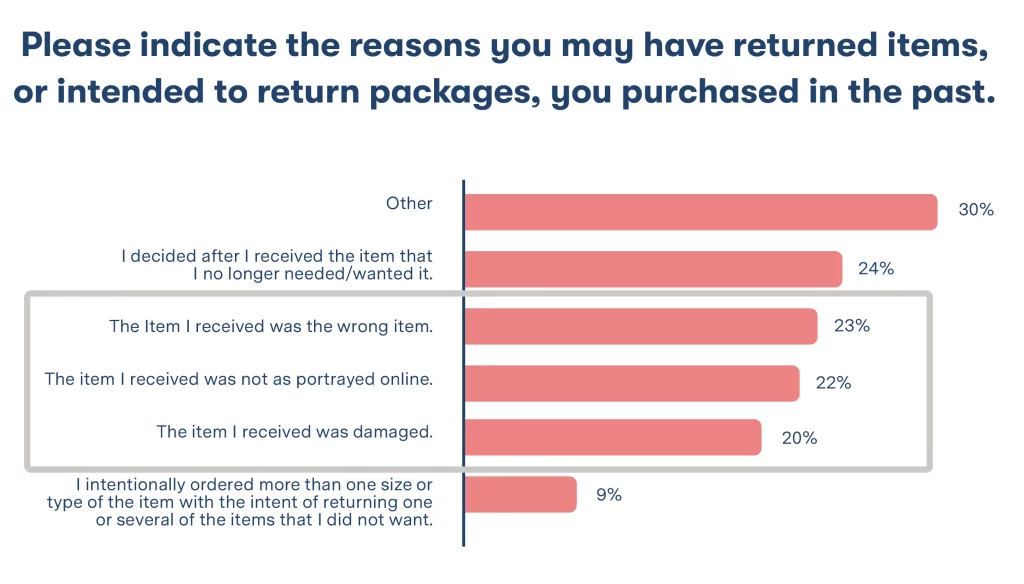What Customers Want to See in a Return Policy

Let’s face it. If you want to keep customers happy and coming back, returns are a necessary part of doing business. While they will never go away, with the correct return policy strategies, returns can actually improve profits.
Before setting up a customer-focused return policy, remember that:
- It costs as much as 5x more to get a new customer than to deal with unhappy customers.
- Customers care about return policies. In fact, 90% of adult US shoppers said that a convenient returns policy was important when deciding where to make a purchase.
Many Returns Are Not the Customer’s Fault
Forrester conducted a study for UPS that showed as much as 65% of returns were caused by retailers, not by consumers.

- 23% of the time, a return was due to the wrong item being sent to consumers by the retailer.
- 22% of the time, a return was due to the product looking significantly different upon receipt by the consumer.
- 20% of the time, the consumer received a damaged product and was issued a return or exchange.
Customers, of course, make returns for a variety of reasons. Maybe their product arrived damaged, didn’t work correctly, didn’t fit, or didn’t meet their expectations.
According to Statista, nearly 41% of shoppers purchase with the intent of returning for these reasons.
However, without a good return policy and system for handling returns, they can take a lot of time away from business operations.
Why do you need a return policy?
Return policies create important customer guidelines to help retailers manage how customers complete returns and exchanges. However, getting a return can be disheartening and can result in short profit losses.
The Downside of a Poor Return Policy
It can be easy to ignore a return policy altogether. Over time, however, return policy complaints will trickle in online as comments on social media ads, posts, or even Google searches. Customers are less likely to make additional purchases.
For this reason, ignoring customer-centric return policies actually results in more profit loss than implementing a customer-focused returns policy.
The Advantages of a Customer-Focused Return Policy
According to UPS, a website’s return and exchange policy gets viewed by 68% of shoppers. Additionally, according to one CNBC article, offering free returns can increase online sales by 357%.
Customer-focused return policies often make the difference between solid repeat purchase rates and one-time purchases.
Exchanges and returns may not appear profitable at first glance. However, the positive customer experience is likely to lead to higher customer retention and revenue growth.
How to Make a Customer-Centric Return Policy
1. Create a time limit.
Determine the amount of time that purchasers have to return an item. Most retailers choose a 90-day return policy. Some stores, such as L.L.Bean, now allow customers to return items at any time. Brands that do not have time limits should market this policy to show customers how dedicated they are to their satisfaction.
2. Create exceptions.
Most return policies have exceptions. Here are some examples:
- Makeup can only be returned unopened
- Clothes must be in like-new condition
- Open electronics returns are warranty returns only.
These exceptions should be displayed prominently to avoid any confusion and improve customer satisfaction.
Returns are part of the customer experience.
Returns must be just as easy as the purchase experience; otherwise, customer loyalty and retention decrease.
Beyond lenient customer return policies, it’s essential to look at the products returning and implement appropriate changes. For example:
- If the customer ordered the wrong product or size, offer the correct product or size.
- If the product did not match the description, check the product description and make updates as needed.
- If the product did not meet expectations, look into ways to improve the quality of the item.
Set Up a Customizable RMA Solution
E-commerce companies can set up ReturnLogic as an RMA solution for their online store.
With ReturnLogic, retailers can:
- Create a customized customer self-service returns experience. Purchasers can submit their own returns without emailing or calling a customer service department.
- Send custom automated notifications. Let customers know about the status of their returns automatically.
- Automate the e-commerce returns experience internally and externally.
- Accept warranty claims on purchases made outside of the retailer’s e-commerce site.
Setting up a powerful RMA solution isn’t just good for business; it also creates an effortless customer experience to build loyalty and increase sales.
When handling returns, it’s essential to create an exceptional customer experience.
- Make the inquisition process simple. Set up your RMA system to ask questions to understand the return better. For example, if a customer is returning a shirt and selects “too small” as the reason, prepare additional questions to help improve the product. For example, “too small in the arms,” “too small in the chest,” etc.
- Make the return process as quick and straightforward as possible. It starts with a clearly written return policy and follows with intelligent RMA process implementation.

Product returns are simply a part of being in business as a successful e-commerce store. Retailers should improve the customer returns experience and track customer lifetime value improvements, rather than eliminating returns and losing repeat business.





